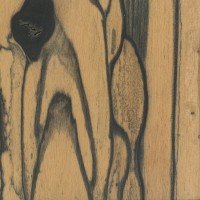 |
Common Name(s): Black and White Ebony, Pale Moon Ebony Scientific Name: Diospyros malabarica (syn. Diospyros embryopteris, D. peregrina) Distribution: Laos and southeast Asia Tree Size: 50-115 ft (15-35 m) tall, 1-3 ft (.3-1 m) trunk diameter Average Dried Weight: 51 lbs/ft3 (825 kg/m3) Specific Gravity (Basic, 12% MC): .67, .82 Janka Hardness: 1,780 lbf (7,920 N) Modulus of Rupture: No data available Elastic Modulus: No data available Crushing Strength: No data available Shrinkage: No data available |
Color/Appearance: Heartwood is a pale straw color, with darker black streaks throughout; some pieces may be predominantly black rather than white. Sapwood is a paler white color, not always clearly defined.
Grain/Texture: Generally straight grain with a fine, uniform texture and good natural luster.
Endgrain: Diffuse-porous; medium to large pores in no specific arrangement, few; solitary and radial multiples of 2-3; heartwood deposits occasionally present; parenchyma reticulate, diffuse-in-aggregates, vasicentric; rays narrow, spacing close.
Rot Resistance: Reported to be very durable; moderate insect/borer resistance, though portions of the wood commonly have insect holes present.
Workability: Generally works and turns well, though pieces can be difficult to dry without checking.
Odor: No characteristic odor.
Allergies/Toxicity: Although severe reactions are quite uncommon, Ebony in the Diospyros genus has been reported as a sensitizer. Usually most common reactions simply include eye and skin irritation. See the articles Wood Allergies and Toxicity and Wood Dust Safety for more information.
Pricing/Availability: Not commonly available, Black and White Ebony is very expensive, on par with solid-black species of ebony.
Sustainability: This wood species is not listed in the CITES Appendices or on the IUCN Red List of Threatened Species.
Common Uses: Turned objects, inlay, and other small wood projects.
Comments: Density is reported to vary significantly depending upon the concentration of darker heartwood as compared to the lighter sections.


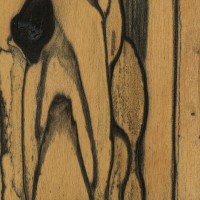
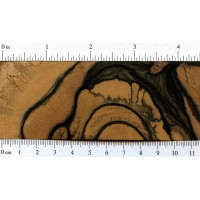
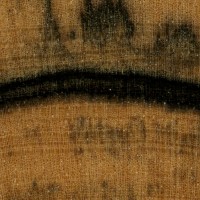
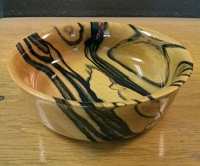

I have not heard of Black and White Ebony and was wondering if it could be used for rifle stocks?
Wuh-bam.
This wood is so beautiful in reference to this drippy droop black on top white grain markings. and one of the easiest woods to cut in terms of NOT having to apply a lot pressure upon any one dimension of the wood when using tools with very sharp edges. I will advise to all that see this comment that you you need to keep you hand saws sharp and use “clog-resistant” “sand-paper” working with this beautiful black and white wood.
In our country, ebony is a precious wood, often used as high-class furniture and I like it
End-grain view of a Black & White Ebony yo-yo. Turning is easy but finishing, without getting cracks in the surface, is very difficult. Good looking wood but a general PITA to work with.
Very expensive – YES! Checked like crazy – YES! Turns nicely – YES – Beautiful outcome – YES.
I have been reading how workable this wood is supposed to be and looked at it’s Janka hardness rating but I am finding my specimens to be about as hard as bathroom tile to cut and they do have a lot of “white” in them.
It is a good wood.
We often use ebony for fine furniture.
In our country, ebony is a precious wood, often used for fine furniture and I like this wood
You can use the wood for design interior of arpartment.
So great!
I have been reading how workable this wood is supposed to be and looked at it’s Janka hardness rating but I am finding my specimens to be about as hard as bathroom tile to cut and they do have a lot of “white” in them.
I would like to know if this specific wood can be used for eating off of. i.e., a turned bowl or a utensil?
Adam, Almost any wood can be used to eat from, however, since many woods are toxic, they must be finished with a specific poly-urithain called “Salad Bowl Finish” This finish seals the wood and keeps any toxins from leaching out.
This might be an issue of semantics, but actually very few woods are outright toxic (which would mean it would universally cause ill reactions in all people). However, many woods can cause allergic reactions, but it varies from person to person.
Basically, most of these projects are simply calculated risks. It all boils down to how much of a risk of causing an allergic reaction in a sensitive individual you are comfortable with.
Carnauba wax at cosmetic/food (A.k.a Tipo1) grade can be used for a low gloss finish
This wood is so beautiful in reference to this drippy droop black on top white grain markings. and one of the easiest woods to cut in terms of NOT having to apply a lot pressure upon any one dimension of the wood when using tools with very sharp edges. I will advise to all that see this comment that you you need to keep you hand saws sharp and use “clog-resistant” “sand-paper” working with this beautiful black and white wood.